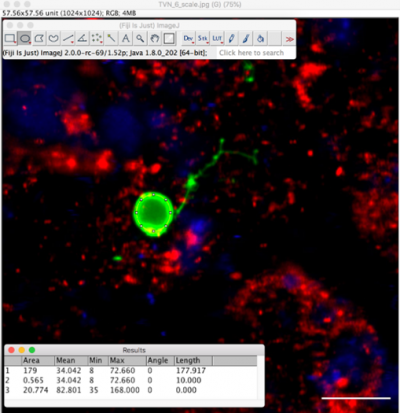McKenna Crawford

Summer 2020 Remote Research
This summer, I worked remotely on a project in the Derbyshire lab investigating the role of host aquaporin-3 (AQP3) in the asymptomatic liver stage of malaria. I compiled hundreds of microscopy images of liver stage Plasmodium vivax parasites that are responsible for a significant portion of malaria cases (images taken by graduate student Kayla Sylvester). I used the Fiji software to measure the size of each parasite to classify them as either small form dormant hypnozoites or larger, actively developing schizonts. I also classified tubovesicular network (TVN) features that protrude from the membrane of some of the parasites, which have been proposed to be important to the parasite’s immune evasion abilities and were previously uncharacterized in Plasmodium vivax. Investigating host AQP3 colocalization to Plasmodium vivax dormant hypnozoites and their TVN features will help to characterize interesting potential drug targets for malaria –– targets which may even be able to prevent malaria relapse via inhibition of host AQP3 and/or the TVN of dormant hypnozoite forms. Additionally, I spent my time working remotely this summer learning the software, skills, and background knowledge necessary for the continuation of the project. I worked on learning how to use SnapGene for virtual DNA cloning and plasmid synthesis, GraphPad Prism for statistical analysis and generating graphs, Adobe Illustrator for making figures, and coding in R for statistical analysis. I also participated in weekly journal clubs to better understand new research in the field, and searched through existing literature for known transcriptional regulators of host AQP3. Although in-person research was not possible this summer, I made progress towards understanding liver stage malaria and the role of host AQP3 by analyzing microscopy data, and I learned a lot about the software, skills, and background knowledge necessary for the future of this project.